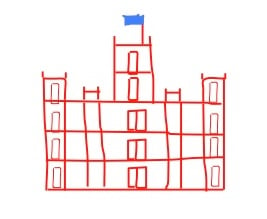The PBS Masterpiece Theatre period costume drama, Downton Abbey is a masterful example of visual storytelling, featuring superb British acting talent, staged in the magnificent Highclere Castle, (hailed as the best castle in England).
It's the best TV drama I have seen for a very long time and a welcome departure from the US election news; I'm a huge fan and recommend it to anyone interested in quality entertainment.
For those who have not yet seen Downton Abbey, Series 2 is playing on Masterpiece Theatre on Sunday evening in the US, on the PBS channels.
Downton Abbey has enormous appeal across age groups from 10 years old to 100 and is being shown in 100 viewing territories. It is hugely popular in the US, UK and is the biggest television hit in Spain for 10 years.
Downton Abbey is a beautifully written and visually compelling story from a time of tremedous social upheaval, World War 1. The characters are fully developed; the aristocrats restrained and rule-bound by the mores of the era and the servants, subjugated by dutiful obedience. The superb grounds and the setting of Highclere is stunning.
The essence of great storytelling is our ability to identify and connect with the aspirations and frustrations of the characters in the story as they confront their personal challenges. The tension and excitement in the struggle to overcome them as the story unfolds makes the next episode a compelling must-watch event and a reason for staying in on Sunday evenings.
How can we apply these lessons in selling?
John Kotter, Harvard Business School professor, and author of "Leading Change" who comments on the power of visual storytelling states, "Over the years I have become convinced that we-learn best-and change-from hearing stories that stike a chord within us. Those in leadership positions, who fail to grasp or use the power of stories, risk failure for their comanies and themselves".
Salespeople are leaders running their own business franchise and John Kotter's advice is highly relevant.
Top Salespeople are Natural Storytellers
I'm currently working on a whiteboard story for a leading technology company and have received contributions from some of the sales and marketing stars in the company over the course of its development.
What struck me about a number of the salespeople and marketing team members is their use of story in discussing their products.
- They use anecdotes and simple, yet powerful metaphors when talking about how their products are used.
- Use cases come alive through examples that are relevant and compelling.
- They create tension in their discussion around the use of their products to differentiate themselves from the competition.
- They have figured out how to tell their story naturally....without a script.
Bottling your Story
Our goal in creating Whiteboards is to capture and bottle the magic from the top performers and create a story around how the products are used to overcome problems with the status-quo and have everyone on the customer-facing team learn it and have fun telling it.
When the buyer is at the center of your story vs. your products and the story captures their current situation and their struggle, then you are well positioned to have your capabilities unfold naturally in conversation.
Combining Visual Imagery and Story
The earliest evidence of Visual storytelling is 35,000 years ago in the paleolithic cave paintings in Chauvet Cave, South of France. With the advent of the slide projector and then PowerPoint, we forgot how to tell stories and let the bullets and slides do the talking.
The best presentations in sales communication successfully integrate simple images with product value-creation and weave a story around the buyer condition.
When we use whiteboards to tell our story vs. PowerPoint bullets, we use simple hand drawn images (that are immediately meaningful in the context of the discussion), interwoven into a story around issues that the buyer is potentially struggling to overcome.
In a WhiteboardSelling enablement symposium, everyone on the customer-facing team learns to draw the whiteboard and to tell their story and in half a day, they will have learned the story well enough to use it with prospective customers the next day...although they may be somewhat uncomfortable until they have mastered it.
There is massive difference in the level of cognition in the audience between an un-trained novices scrawled notes on a whiteboard and the whiteboard created by a person trained to present a visual story and to use icons to convey meaning.
Buyers will often remember a well constructed whiteboard story months after the interaction; scrawled notes on a whiteboard will not be stored in our brain in the same way a poor PowerPoint presentation is discarded from our memory.
Take-Aways:
- The essence of selling is effective communication and the most effective communication uses simple visual images interwoven into a story.
- For those who enjoy British humor, a spoof of Downton Abbey for last year's Red Nose Day charity fundraising event is hilarious. Links below.
http://www.youtube.com/watch?v=r5dMlXentLw
http://www.youtube.com/watch?v=p3YYo_5rxFE - PBS Interview with the producer and cast members
- Learn more about the science behind WhiteboardSelling Enablement.


